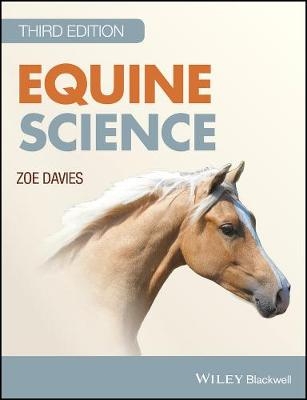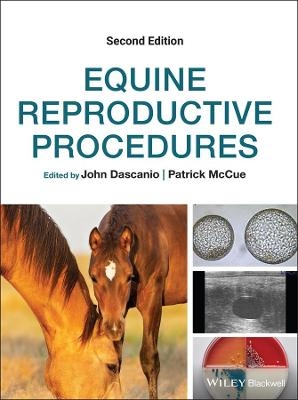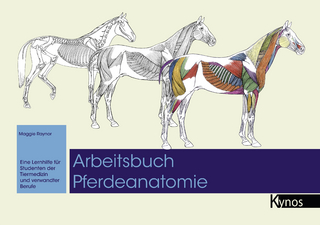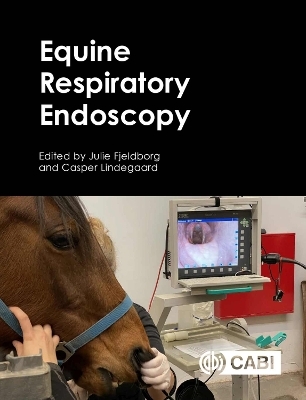
Equine Science
Wiley-Blackwell (Verlag)
978-1-118-74118-4 (ISBN)
Describes the structure and function of the various body systems of the horse
Explains the scientific rationale behind modern equine training practices
Features new chapters on exercise physiology and the evolution of the horse
Reflects the latest scientific advances and changes in the student curriculum
Includes new information on circadian rhythms and sleep patterns, the immune system, and hindgut microbiology.
A powerful teaching and learning aid, Equine Science, Third Edition is an essential text for students on higher education equine studies and equine science programmes, as well as those studying for BHS qualifications up to BHSII Stage 4 Horse Knowledge and Care.
Zoe Davies is one of only a handful of qualified and Registered Equine Nutritionists in the UK. A former lecturer and external examiner in Equine Science, Zoe is a referral nutritionist, specialising in bloodstock and performance horses.
Preface xxiii
Acknowledgement xxv
1 The Biochemical Nature of Cells 1
Metabolism 1
Water 1
Important Properties ofWater 4
Proteins 4
Basic Structure of Amino Acids 4
Polypeptides 5
Levels of Protein Structure 5
Primary Structure of Proteins (Amino Acid Sequence) 6
Secondary Structure of Proteins (Alpha Helix or Beta Pleated Sheet) 6
Tertiary Structure of Proteins (3D Shape/Folding) 7
Quaternary Structure of Proteins (Aggregations of Polypeptide Chains) 7
Classification of Proteins 7
Structure of Collagen 8
Modification of Proteins 8
Denaturation of Proteins 8
Carbohydrates 8
Fructans 9
Starch 10
Cellulose 11
Glycogen 11
Lipids/Fats 11
Triglycerides 12
Essential Fatty Acids 12
Phospholipids 13
Cholesterol 15
Nucleic Acids 15
Deoxyribonucleic Acid (DNA) 15
Ribonucleic Acid (RNA) 16
Messenger RNA (mRNA) 17
Transfer RNA (tRNA) 18
Ribosomal RNA (rRNA) 18
Protein Synthesis 18
Transcription 18
Translation 20
The Genetic Code 21
Reading the Genetic Code 23
Enzymes 23
Factors that Affect the Activity of Enzymes 25
Temperature 25
pH 25
Enzyme Concentration 25
Substrate Concentration 25
Cofactors and Coenzymes 25
Enzyme Inhibitors 25
Metabolic Poisons 26
Drugs 26
Summary Points 26
Q + A 27
2 Cells, Tissues and Organs 29
Cells – Building Blocks of Life 29
Prokaryotic Cells 29
Eukaryotic Cells 31
Cell Function 31
Cytoplasm 32
Cytosol 32
Movement of Substances in and around Cells 32
Cell Organelles 32
Cytoskeleton 32
Cell or Plasma Membrane 33
The Fluid Mosaic Model of Cell Membrane Structure 34
The Role of Membranes in Cell Organelles 34
Nucleus 37
Endoplasmic Reticulum and Ribosomes 38
Golgi Body (Dictyosome) 38
Mitochondria 38
Lysosomes 38
Peroxisomes (Microbodies) 39
Centrosomes 39
Apoptosis (Programmed Cell Death) 39
Cell Turnover 40
Cell Division (Mitosis and Meiosis) 40
The Cell Cycle 40
Mitosis 41
Key Events 41
Cytokinesis or Cytoplasmic Division 43
Meiosis 44
Key Events 45
First Meiotic Division 46
Second Meiotic Division 46
Cell Signalling 46
Cell Differentiation and Stem Cells 46
Blood Cell Production from Stem Cells 47
Tissues and Organs 47
Epithelium/Epithelial Tissue 48
Epithelial Cell Shapes 50
Epithelial Arrangement of Cells 50
Connective Tissue 51
Connective Tissue Cells 52
Connective Tissue Fibres 52
Tissue Repair 53
The Four Stages ofWound Healing 54
Stage 1 – Traumatic Inflammatory Phase 54
Stage 2 – Destructive Phase (0–3 Days) 54
Stage 3 – Proliferative Phase (3–24 Days) 55
Stage 4 – Maturation Phase (24 Days to 2 Years) 56
Ageing Tissue 56
Stem Cell Therapy 56
Summary Points 57
Q + A 58
3 Equine Support and Movement 59
Points of the Horse 59
The Skeletal System 59
Bone 59
Classification of Bone Tissue 60
Dense or Compact Bone 60
Spongy or Cancellous Bone 61
Types of Bones 61
Microscopic Bone Structure 64
Bone Formation and Growth 64
Developmental Orthopaedic Disease 67
Bone Remodelling 68
Hormones and their Effect on Bone Growth 68
Effect of Exercise on Bone Tissue 69
Calcium Homeostasis 69
Bone Fracture and Repair 69
The Skeleton 70
The Axial Skeleton 70
The Skull 70
The Vertebral Column or Spine 71
The Appendicular Skeleton 75
Forelimb 76
Hindlimb 79
Stay Apparatus 80
The Mechanics of Movement 80
Joints 80
Types of Joints 81
Movement of Joints 83
Ageing of Joints 83
Muscles 83
CardiacMuscle 84
Smooth Muscle 84
Skeletal Muscle (Voluntary or Striated Muscle) 85
The Sliding FilamentModel 87
Muscle Anatomy 87
Muscles of the Neck and Shoulder 91
Brachiocephalic 91
Sternocephalic 91
Splenius 91
Trapezius 91
Rhomboideus 95
Deltoideus 95
Triceps 95
Muscles of the Trunk 95
Latissimus Dorsi 95
Pectorals 95
Muscles of the Forearm 95
Digital Extensor 95
Digital Flexor 95
Muscles of the Abdomen 97
Intercostal Muscles 97
Longissimus Dorsi 97
Muscles of the Hindlimb 97
Gluteal 97
Biceps Femoris 97
Semitendinosus 97
Digital Extensor 97
Gastrocnemius 99
The Importance of Muscle Fibres in Equine Performance 99
Muscle Fibre Types 99
Muscle Fibre Recruitment 100
Fatigue 101
Causes of Fatigue 101
Lactic Acid Accumulation 101
Summary Points 101
Q + A 101
4 TheLowerLimb 103
Tendons and Ligaments of the Lower Limb 103
Tendons 103
Tendon Repair 104
Extensor Tendons 106
Flexor Tendons 106
Ligaments and Suspensory Apparatus 106
Check Ligament 106
Suspensory Ligament 106
Blood Supply to the Lower Leg 107
The Hoof 107
The Hoof as a Plastic Structure 107
Effect of Movement on Hoof Structure 111
Functions of the Hoof 112
Shock Absorption 112
Grip 112
Circulation 113
The External Hoof 113
Wall 113
Sole 116
Frog 116
Hoof Horn 118
Internal Structures 118
Digital or Plantar Cushion 118
Lateral (Ungual) Cartilages 119
Pedal and Navicular Bones 119
The Balanced Foot 119
Assessment of Foot Balance 119
Static Foot Balance 119
Dynamic Foot Balance 120
Adaptations of Hoof Tissue 121
Summary Points 121
Q + A 122
5 The Digestive System 123
Foregut 124
Mouth 124
Oesophagus 127
Stomach 127
Gastric Juice 128
Small Intestine 130
Pancreas 132
Endocrine Functions of the Pancreas 132
Exocrine Functions of the Pancreas 133
Liver 134
Functions of the Liver 135
Hindgut 137
Large Intestine 137
Caecum 137
Large Colon 137
Small Colon 140
Rectum 140
Digestion in the Large Intestine 140
Equine Microbiota 140
The Gut and the Immune System 142
Summary Points 142
Q + A 143
6 The Respiratory System 145
Anatomy 146
Within the Head and Neck 146
Within the Chest 148
Blood Supply 149
Pleurae 149
Diaphragm 150
Physiology of Respiration 150
Pulmonary Ventilation 150
Pressure Changes during Breathing 151
Airway Resistance 151
Lung Air Volumes and Capacities 151
Dead Space 153
Regulation of Breathing 153
Respiratory–Locomotor Coupling 154
External Respiration or Pulmonary Gas Exchange 155
Internal Respiration or Systemic Gas Exchange 156
Transport of Oxygen and Carbon Dioxide Around the Body 157
Oxygen Transport 157
Carbon Dioxide Transport 157
The Oxygen Dissociation Curve 158
The Bohr Effect 158
Cellular Respiration 159
Aerobic Cellular Respiration 159
Aerobic Respiration of Glucose 161
Glycolysis 161
Link Reaction 161
Krebs Cycle 163
Electron Transport Chain 163
Aerobic Respiration of Other Fuels 166
Glycogen 166
LipidMetabolism 166
Protein Metabolism 167
Anaerobic Respiration 167
Summary Points 167
Q + A 168
7 The Circulatory System 169
Foetal Circulation 170
The Heart 171
Cardiac Output 172
Anatomy of the Heart 173
The Cardiac Cycle 175
Regulation of the Heart Beat 175
The Heart and Fittening/Training Horses 176
The Heart and VO2 Max 178
Heart Murmurs 178
Heart or Cardiac Arrhythmia 178
Second-Degree AV Block 179
Atrial Fibrillation (AF) 179
Sudden Cardiac Death 179
Blood Vessels 179
Arteries 179
Veins 180
Capillaries 182
Heart Evaluation and Examination 182
Electrocardiogram 182
Exercise Testing of Horses 183
Blood 184
Plasma 184
Red Blood Cells (Erythrocytes) 185
White Blood Cells (Leucocytes) 186
Granulocytes 188
Agranulocytes 189
Platelets (Thrombocytes) 190
Haemostasis or Blood Clotting 190
Blood Tests 191
Blood Typing 191
The Lymphatic or Lymph System 192
The Spleen 193
Summary Points 194
Q + A 194
8 The Nervous System 197
Nerves and Neurons 198
Neuroglia or Glial Cells 200
Organisation of the Nervous System 202
CNS 202
PNS 203
Action Potential 203
Resting Membrane Potential 204
Synapses 206
Transmission at the Synapse 207
Neurotransmitters 208
Endorphins and Enkephalins 208
Neuromuscular Junctions 209
The Brain 209
Forebrain 210
Hypothalamus 210
Thalamus 210
Cerebrum 210
Midbrain 210
Hindbrain 210
Spinal Cord 212
Reflex Actions or Arcs 212
Summary Points 212
Q + A 213
9 The Endocrine System 215
Hypothalamus 216
Pituitary Gland (Hypophysis) 217
Anterior Pituitary – Adenophysis 217
Pars Intermedia 218
Posterior Pituitary (Neurophysis) 218
Thyroid Gland 219
Thyroid Hormones 219
Parathyroid Glands 219
Adrenal Glands 220
Adrenal Cortex 221
Mineralocorticoids 221
Glucocorticoids 222
Adrenal Medulla 222
Pancreas 222
Secretion of Glucagon and Insulin 224
Thymus 225
Ovaries 225
Equine Chorionic Gonadotropin 226
Testes 226
Pineal Gland 227
The Neuroendocrine System 228
Circadian Rhythms in Horses 230
Sleep Patterns in Horses 231
Summary Points 232
Q + A 233
10 The Skin 235
Structure of the Skin 235
Epidermis 237
Stratum Basale 238
Stratum Spinosum 238
Stratum Granulosum 238
Stratum Lucidum 238
Stratum Corneum 238
Dermis 238
Sensation 239
Melanin 239
Sudoriferous Glands (Sweat Glands) 239
Sebaceous Glands 239
Hair 239
Hair Follicles 240
The Coat 241
Thermoregulation 241
Heat Conservation 243
Heat Loss 243
Sweating 245
Breaking Out 246
Dry Coat or Anhydrosis 246
Skin and Coat Colour 246
Summary Points 247
Q + A 247
11 The Senses 249
Transduction 249
Adaptation 249
Somatic Receptors 250
Thermal Sensations 250
Pain Sensations 251
Tactile Sensations 251
Itch Sensation 252
Proprioceptor Sensation 252
Special Senses 253
Sight 253
Visual Streak of the Eye 253
Colour Vision 254
Night Vision 254
Anatomy of the Eye 254
Chambers of the Eye 255
Photoreceptors 256
Transmission of Nerve Impulses to the Brain 258
Accommodation (Focusing) 258
Adaptation of the Horse’s Eyes to Light 258
Eyelids 259
Conjunctiva 259
Lacrimal Apparatus 260
Hearing and Balance 260
Anatomy of the Ear 261
Taste and Smell 264
The Olfactory System 265
Jacobson’s Organ 265
Summary Points 266
Q + A 266
12 Reproduction 267
Reproductive Anatomy of the Mare 267
Vulva 267
Vagina 269
Cervix 269
Uterus 269
Utero-tubular Junction 270
Fallopian Tubes 270
Ovaries 271
The Oestrus Cycle 272
Follicular Development or Oogenesis 275
Ovarian Changes during the Oestrus Cycle 275
Behavioural Signs of Oestrus in the Mare 276
Summary of Mare Behaviour through the Cycle 276
Endocrine Changes during the Oestrus Cycle 277
Artificial Control of the Oestrus Cycle 278
Light 279
Hormonal Methods 280
Postponing Ovulation 280
Reproductive Anatomy of the Stallion 280
Scrotum 280
Testes (Testicles) 281
Epididymis 282
Vas Deferens 284
Accessory Sex Glands 284
Vesicular Gland (Seminal Vesicles) 284
Prostate Gland 284
Bulbo-Urethral Gland (Cowper’s Gland) 284
Penis 284
Spermatogenesis 285
Acrosome Reaction 286
Endocrine Pathways in the Male 287
Fertilisation 287
Pregnancy Diagnosis 287
Foetal Sexing 288
Twins 289
Endocrine Maintenance of Gestation 289
Equine Chorionic Gonadotropin 290
Progesterone 290
Oestrogens 290
Relaxin 290
Gestation 291
Implantation and Placentation 291
Embryology 292
Phases of Equine Embryo Development and Migration 293
Phase 1 294
Phase 2 294
Phase 3 294
Phase 4 294
Phase 5 294
Phase 6 294
Timeline of Embryonic Development 294
The Foetal Endocrine System 295
Preparation for Parturition (Birth) 295
The Three Stages of Parturition 296
Stage 1 296
Stage 2 296
Stage 3 296
Induction 296
Lactation 297
Lactogenesis 297
Lactation Curve 298
Applied Reproductive Technologies 298
Artificial Insemination 298
Advantages 299
Disadvantages 299
Collection of Semen 299
Semen Preservation 300
Embryo Transfer 301
Advantages 302
Disadvantages 302
Donor and Recipient Mares 302
The Synchronisation Process 302
Collection of the Embryo 302
Transfer of the Embryo 303
Gamete Intrafallopian Transfer 303
Oocyte Transfer 303
Intracytoplasmic Sperm Injection (ICSI) 303
Summary Points 303
Q + A 304
13 Genetics 305
The Genetic Code or Genome 305
Chromosomes 305
Gene Expression 306
Mitochondrial DNA 307
The Y Chromosome 308
Alleles 308
Dominance 308
Sex Cells 309
Hybrids 309
Heredity 309
Sex Determination 310
Genotype and Phenotype 311
Polygenic or Multiple Gene Traits 311
Multiple Alleles 311
Sex Linkage 311
Lethal Genes 311
Lethal White Foal Syndrome (LWFS) 311
Foal Immunodeficiency Syndrome (FIS) 311
Lavender Foal Syndrome (LFS) 312
Severe Combined Immunodeficiency (SCID) 312
Congenital Curly Coat Syndrome 312
Epigenetics 312
Muscle Disorders 314
Nuclear Transfer (Cloning) 314
Parental Similarity of Clones 314
Mutation 315
Gene Mutation 315
Chromosome Mutation 316
Non-Disjunction 316
Polyploidy 316
Single Nucleotide Polymorphisms 317
The Myostatin Gene and Performance 317
Coat Colour and Genetics 317
Bay/Black 318
White (Albino) (WWorWw) 318
Grey (GG or Gg) 318
Roan 320
Spotting Patterns 320
Sabino (SB1) 320
Tobiano (TO or to) 320
Overo (O) 320
Appaloosa (LP) 320
Cream (C or Ccr) 321
Silver (Z) 323
Champagne 323
Pearl 323
Dun (D or d) 323
White Markings 323
Melanomas in Grey Horses 323
Exercise-Induced Pulmonary Haemorrhage (EIPH) or Epistaxis 323
Summary Points 324
Q + A 324
14 The Urinary System 325
Kidneys 325
Nephrons 327
Role of Tubules in Formation of Urine and in Homeostasis 331
Proximal Convoluted Tubule 331
Loop of Henle 332
Distal Convoluted Tubule 333
Regulation ofWater 334
Regulation of Permeability of the Collecting Ducts by ADH 334
Aldosterone 335
Acid–Base Balance 335
Extracellular and Intracellular Chemical Buffers 336
Protein Buffer System 336
Carbonic Acid–Bicarbonate Buffer System 336
Phosphate Buffer System 336
Carbon Dioxide Exhalation 337
Excretion of Hydrogen Ions 337
Acid–Base Imbalances 337
Micturition or Urination 337
Summary Points 338
Q + A 338
15 The Immune System 339
Health Versus Disease 339
Microbes 339
Disease Transmission Routes 340
Infection 340
Biofilms 341
Symptoms of Disease 341
Diagnosis 342
Pathogenic Organisms 342
Bacteria (Prokaryotes) 342
Invasive Properties 343
Spread of Bacteria 344
Mycoplasma Species 345
Antibiotics and Resistance 345
Viruses 346
Structure 347
Replication 348
Eukaryotic Pathogens 348
Fungi 348
Protozoa 350
Internal Parasites 351
Protection from Disease 351
External Barriers 351
Innate Immunity 353
Inflammation 353
Interferons 355
Complement System 356
Natural Killer Cells 356
Adaptive/Acquired Immunity 357
Types of Adaptive/Acquired Immunity 357
Antigens and Antibodies 361
Antigen Presentation 362
Ingestion of an Antigen – Mode of Action 362
T Cells and Cell-Mediated Immunity 363
Helper T Cell Activation 363
Cytotoxic T Cells 363
Summary Points 364
Q + A 364
16 Exercise Physiology, Functional Anatomy and Conformation 365
Exercise Physiology 365
Fitness 365
Horses at Rest 365
Exercise 365
Exercise and Energy 366
Fuels Available for Exercise 367
Immediate Response of the Horse’s Body to Exercise 368
Changes Occurring during Exercise 368
Homeostatic Mechanisms Involved during Exercise 369
LactateThreshold 370
Over-training 370
Recovery 370
Long-Term Responses of the Horse’s Body to Exercise 371
Fitness Training 373
PreliminaryWork 373
DevelopmentWork 374
FastWork 374
Interval Training 374
Aims of Interval Training 374
Monitoring Interval Training 375
Beginning Interval Training 375
How to Use Interval Training 375
Points Regarding Interval Training 375
Functional Anatomy 376
Centre of Gravity 376
Stay Apparatus 377
Moving the Front Legs 380
Moving the Hind Legs 380
Equine Biomechanics 381
Kinematics 381
Kinetics 381
Conformation 382
Ideal Conformation 382
Head 382
Topline 382
Neck 382
Withers 384
Chest 384
Shoulder 384
Elbow 384
Forelimb 385
Feet 386
Back 386
Hindquarters 387
Summary Points 390
Q + A 390
17 Teeth and Ageing 391
Equine Teeth 391
Wear and Tear 394
Ageing 396
Care of Equine Teeth 399
Summary Points 401
Q + A 401
18 Evolution, Classification and Behaviour of the Horse 403
Evolutionary Time Period 403
Classification 403
Species 404
Evolutionary Development 407
The Evolutionary Family Tree 409
Domestic Breeds and Types of Horses 412
Donkeys 412
Przewalski’s Horse 412
Mustangs 414
Behaviour of the Modern Horse 414
Innate Behaviour 414
Learned Behaviour 415
Habituation 415
Classical Conditioning 416
Operant Conditioning 416
Latent Learning 416
Insight Learning 416
Stereotypies 416
Imprinting 417
The Dopamine Receptor D4 417
Emotion 417
Summary Points 417
Q + A 418
A Anatomical Terms Based on theMedian Plane 419
B Haematology and Plasma Biochemistry Tests 421
C Functions, Sources and Deficiencies of Vitamins andMinerals in Horses 423
Index 429
| Erscheinungsdatum | 07.11.2017 |
|---|---|
| Verlagsort | Hoboken |
| Sprache | englisch |
| Maße | 178 x 252 mm |
| Gewicht | 1021 g |
| Themenwelt | Veterinärmedizin ► Pferd |
| ISBN-10 | 1-118-74118-8 / 1118741188 |
| ISBN-13 | 978-1-118-74118-4 / 9781118741184 |
| Zustand | Neuware |
| Informationen gemäß Produktsicherheitsverordnung (GPSR) | |
| Haben Sie eine Frage zum Produkt? |
aus dem Bereich


